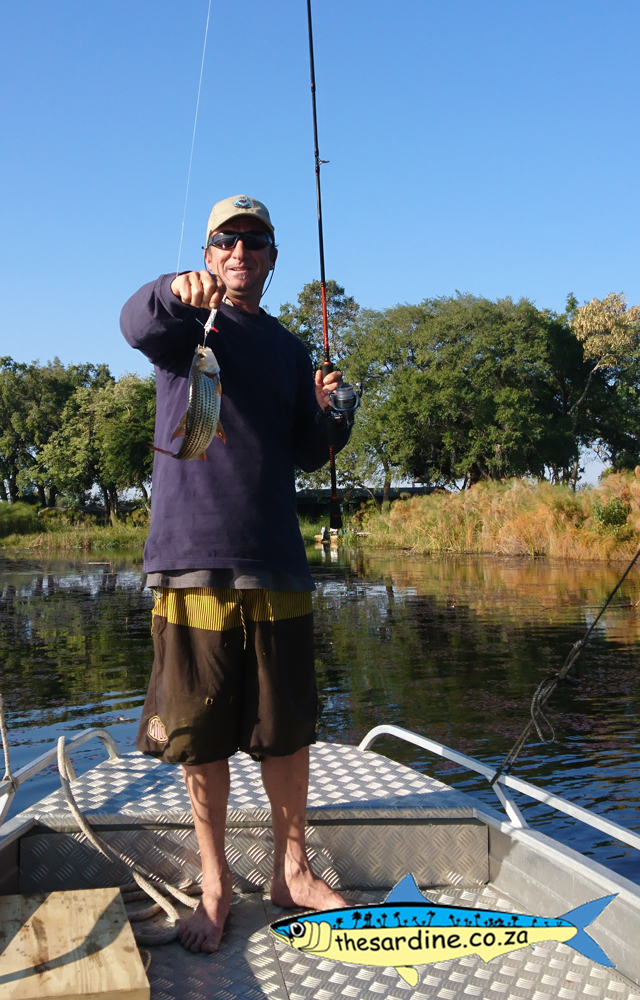
First class first cast Tigerfish on the Delta
As early as the cold dawn and breakfast would allow us, we set off on the tigerfish rich waters afore us. On our maximum fun tinny named Tuni. Captained by local guide and skipper – Julius. Staffed by Joy. Powered by Mercury.
Navigator Cameron Yates conferred with Julius as to a route, to lead to Julius’ childhood village – named Jao. There, our crew were going to interview the elders about traditional land management methods of old. But along the way, Julius would stop at one or two of his favourite fishing spots for us to have a throw.
And into the bright and brisk morning, the outboard accelerated away from our lodge, deep in the Okavango Delta.
It is hard to be anything but quiet as you try to process all the wonder and thrilling beauty you experience charging down those papyrus and lily lined waterways. Which are permanently inhabited by crocodiles. Hippopotamus. And…
Tigerfish!
We had a total of 80kms mapped out for the day. We would only get back to camp late. So fishing time was limited. I was hoping for a few quiet throws whilst the Professor and crew were taking notes in the village.
I had rented two rods earlier. From a vibrant chap named Nine. One was a beautiful outfit that I would have been proud to bring out anywhere. The other was ok, squeaky, and very short. Broken a few eyes down. But Nine also gave me some new line! So hurriedly I tied up some leaders, well double lines had to do, and savaged one of my Mydo couta traces for two short lengths of wire since I have heard all about those teeth.
Then I chose a little Mydo SS Shad 650 spoon for the nice outfit. And a Mydo Luck Shot #1 with 5/0 hook, and an orange Gummy paddletail, for the handicapped outfit. They both looked good though, with their new line and double line, and two very handsome looking lures. I already knew which rod was going to operate.
After an hour of literally flying down these serpentine waterways, the main channel appeared. A few more clicks and the channel split, one way was to Maun, the other to the village Jao, our destination.
Julius stopped the boat, and quietly pointed at the fishing rods.
I surrendered the good outfit and grabbed the underdog. Cameron had the SS Spoon, and I had the Luck Shot. I went to the bow of the good tinny named Tuni. There was a bunch of papyrus that Julius had used to keep us in one place as the water flowed past at a good few knots. So, I perched on one gunwale, found some space behind me, and flicked as best I could.
The lure landed about 8 metres into the middle of the current, so I figured let it sink and go away with the drift, and then close the bail. It all looked good and soon I got a strong bite!
“I got a bite!”, I errupted…
…everyone looked, the tiny rod buckled again and this time I had a first cast fish. Julius mentioned bream casually, and everyone else cheered in absolute disbelief. Thinking bream, I was having so much when the fish started coming closer, and then ducked under the papyrus carpet. Luckily it turned and came out.
Tailwalking!
It was my first cast tigerfish. And it was not nearly in the same class as my last and only tiger, caught in Jozini on sardine. This fish had some size! The tiny rod also had no power whatsoever but finally he jumped himself dizzy and the current let him go to us.
As I pulled him on top of the papyrus carpet, he snapped and bit a papyrus stem. His teeth went right in and held vas. But he was a metre and a half away and smack bang in crocodile country. Luckily Captain Gallop was quick with a knife and cut the papyrus stem at the boat and pulled in my first cast tigerfish.





If you want some calm, fun times fishing with your family and friends, then come with us to the Okavango. We fished a maximum collective time of an hour, over the next few days exploring and documenting. We caught 6 tigerfish. All on the SS Spoons and that first fish on the Luck Shot. We only used the 650 Shad spoon and the Moby – the tiny one.
It was so much fun! No bream this time though. They will have to wait for us a bit. We are back in September.
We have lined up boats, and we have Captain Julius’ number. Camping options close by and lodges up and down. Executive camping outfit is good to go. Land cruisers are loaded, and always ready for any adventure.
Contact Sean on WhatsApp +27 79 326 9671, or better still email as we work in 2G areas mainly. I am on umzimkulu@gmail.com.
Check out our Trips and Travel section in the menu at top, or follow this link…

































